-
Countries
-
Data and Analysis
-
Special Focus
-
Crisis Responses
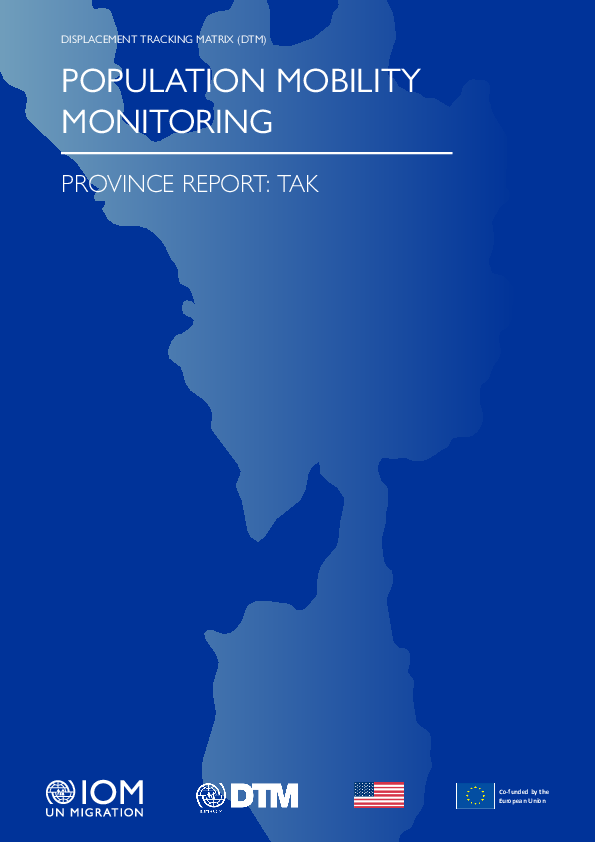
Contact
DTMThailand@iom.int
Language
English
Location
Thailand
Period Covered
Oct 01 2022
Oct 31 2022
Activity
- Flow Monitoring
To better understand health and screening capacities in Thailand, IOM’s Displacement Tracking Matrix (DTM), with support from the US Bureau of Population, Refugees and Migration (PRM) and European Civil Protection and Humanitarian Aid Operations (ECHO), is implementing Population Mobility Monitoring (PMM) along the Myanmar-Thai border. Border provinces selected for data collection include Ranong and Tak. The following report focuses on Tak.
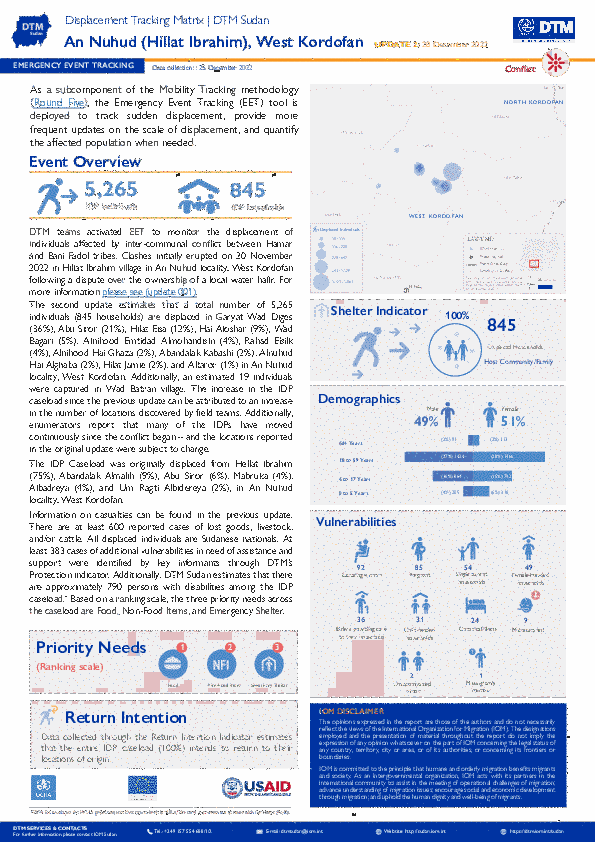
Contact
DTM Sudan; dtmsudan@iom.int
Language
English
Location
Sudan
Snapshot Date
Dec 25 2022
Activity
- Event Tracking
The DTM Emergency Event Tracking (EET) is deployed to track sudden displacement and population movements, provide more frequent updates on the scale of displacement, and quantify the affected population when needed. As a subcomponent of the new Mobility Tracking methodology in Sudan (Round Five), and activated on a need basis, EET utilises a broad network of key informants to capture best estimates of the affected population presence per location – a useful tool for humanitarian response planning and design.
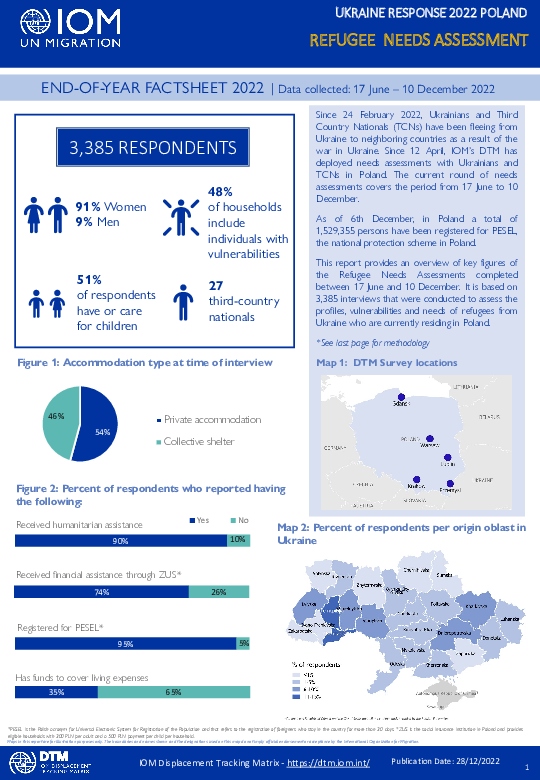
Contact
IOMDTMPoland@iom.int
Language
English
Location
Poland
Period Covered
Jun 17 2022
Dec 10 2022
Activity
- Survey
Since 24 February 2022, Ukrainians and Third Country Nationals (TCNs) have been fleeing from Ukraine to neighboring countries as a result of the war in Ukraine. Since 12 April, IOM’s DTM has deployed needs assessments with Ukrainians and TCNs in Poland. The current round of needs assessments covers the period from 17 June to 10 December.
As of 6th December, in Poland a total of 1,529,355 persons have been registered for PESEL, the national protection scheme in Poland.
This report provides an overview of key figures of the Refugee Needs Assessments completed between 17 June and 10 December. It is based on 3,385 interviews that were conducted to assess the profiles, vulnerabilities and needs of refugees from Ukraine who are currently residing in Poland.

Contact
DTM Europe, DTMMediterranean@iom.int
Language
English
Location
Poland
Period Covered
Apr 12 2022
Dec 10 2022
Activity
- Survey
- Community Perception
Since 24 February 2022, Ukrainians and Third Country Nationals (TCNs) have been fleeing from Ukraine to neighbouring countries as a result of the war in Ukraine. According to The Polish Border Guard data from 6 December, a total of 8.04 million crossings from Ukraine to Poland were recorded at border crossing points (BCPs) since 24th February 2022. IOM’s Displacement Tracking Matrix (DTM) has been collecting information through the Refugee Flows to Poland: Needs and Intentions Survey with refugees using BCPs to cross into Poland since 4 March 2022.
This report provides an overview of key figures of the Refugee Flows to Poland: Needs and Intentions Survey between 12 April and 10 December. It is based on 7,538 interviews that were conducted to assess the profiles and intentions of refugees from Ukraine crossing into Poland. The survey includes both refugees intending to stay in Poland and those transiting through Poland to other countries. The sample is not representative of all persons crossing into Poland, results should hence only be considered as indicative. See last page for methodology.
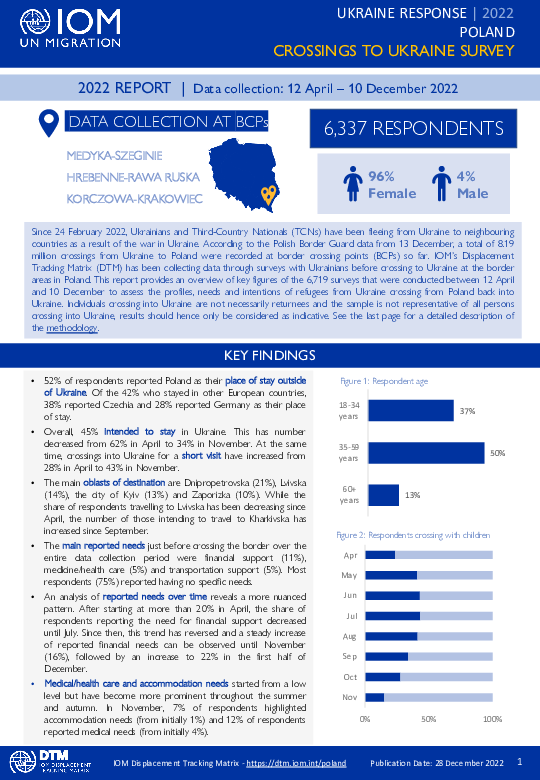
Contact
DTM Europe, DTMMediterranean@iom.int
Language
English
Location
Poland
Period Covered
Apr 21 2022
Dec 10 2022
Activity
- Survey
Since 24 February 2022, Ukrainians and Third-Country Nationals (TCNs) have been fleeing from Ukraine to neighbouring countries as a result of the war in Ukraine. According to the Polish Border Guard data from 13 December, a total of 8.19 million crossings from Ukraine to Poland were recorded at border crossing points (BCPs) so far. IOM’s Displacement Tracking Matrix (DTM) has been collecting data through surveys with Ukrainians before crossing to Ukraine at the border areas in Poland. This report provides an overview of key figures of the 6,719 surveys that were conducted between 12 April and 10 December to assess the profiles, needs and intentions of refugees from Ukraine crossing from Poland back into Ukraine. Individuals crossing into Ukraine are not necessarily returnees and the sample is not representative of all persons crossing into Ukraine, results should hence only be considered as indicative. See the last page for a detailed description of the methodology.
Contact
DTM Yemen, iomyemendtm@iom.int
Location
Yemen
Activity
- Mobility Tracking
Period Covered
Jul 01 2022 -Sep 30 2022
During the reporting period, between 1 July and 30 September 2022, IOM Yemen DTM tracked 1,963 households (HH) (11,778 individuals)1 who experienced displacement at least once. This compares to 2,052 households (12,312 Individuals) in the second quarter representing a four per cent decrease. Since the beginning of the 2022, the number of tracked new instances of displacement has been declining with a truce holding between April and October 2022.
Safety and security concerns as a result of the conflict were the main reason for displacement, accounting for 73 per cent (1,431 HHs) of the total, followed by economic reasons related to conflict, accounting for 13 per cent (256 HHs) and natural disasters (14%, 276 HHs).
Population Groups
Survey Methodology
Unit of Analysis Or Observation
Type of Survey or Assessment
Keywords
Geographical Scope
Administrative boundaries with available data
The current dataset covers the following administrative boundaries

Contact
DTM Yemen, iomyemendtm@iom.int
Language
English
Location
Yemen
Period Covered
Jul 01 2022
Sep 30 2022
Activity
- Mobility Tracking
During the reporting period, between 1 July and 30 September 2022, IOM Yemen DTM tracked 1,963 households (HH) (11,778 individuals)1 who experienced displacement at least once. This compares to 2,052 households (12,312 Individuals) in the second quarter representing a four per cent decrease. Since the beginning of the 2022, the number of tracked new instances of displacement has been declining with a truce holding between April and October 2022.
Safety and security concerns as a result of the conflict were the main reason for displacement, accounting for 73 per cent (1,431 HHs) of the total, followed by economic reasons related to conflict, accounting for 13 per cent (256 HHs) and natural disasters (14%, 276 HHs).
Contact
DTM Yemen, iomyemendtm@iom.int
Location
Yemen
Activity
- Mobility Tracking
- Event Tracking
Period Covered
Dec 18 2022 -Dec 24 2022
From 1 January to 24 December 2022, IOM Yemen DTM tracked 10,090 households (HH) (60,540 Individuals) who experienced displacement at least once.
Between 18 and 24 December 2022, IOM Yemen DTM tracked 73 households (438 individuals) displaced at least once. The majority of people moved into/within the following governorates and districts:
- Marib (39 HHs) – Marib City (22 HHs), Marib (17 HHs) districts. Most displacements in the governorate originated from Ibb and Marib.
- Ad Dali (14 HHs) – Qatabah (10 HHs), Al Azariq (3 HHs), Ad Dali (1 HH) districts. Most displacements in the governorate originated from Ad Dali and Taiz.
- Al Hodeidah (13 HHs) – Hays (7 HHs), Al Khukhah (6 HHs) districts. Most displacements in the governorate were internal.
- Al Hodeidah (15 HHs) – At Tuhayta (5 HHs), Jabal Ras (3 HHs), Hays (3 HHs) districts.
- Taiz (13 HHs) – Mawiyah (5 HHs), Sabir Al Mawadim (2 HHs), Ash Shamayatayn (2 HHs) districts.
- Ad Dali (9 HHs) – Qatabah (9 HHs) district.
Population Groups
Survey Methodology
Unit of Analysis Or Observation
Type of Survey or Assessment
Keywords
Geographical Scope
Administrative boundaries with available data
The current dataset covers the following administrative boundaries
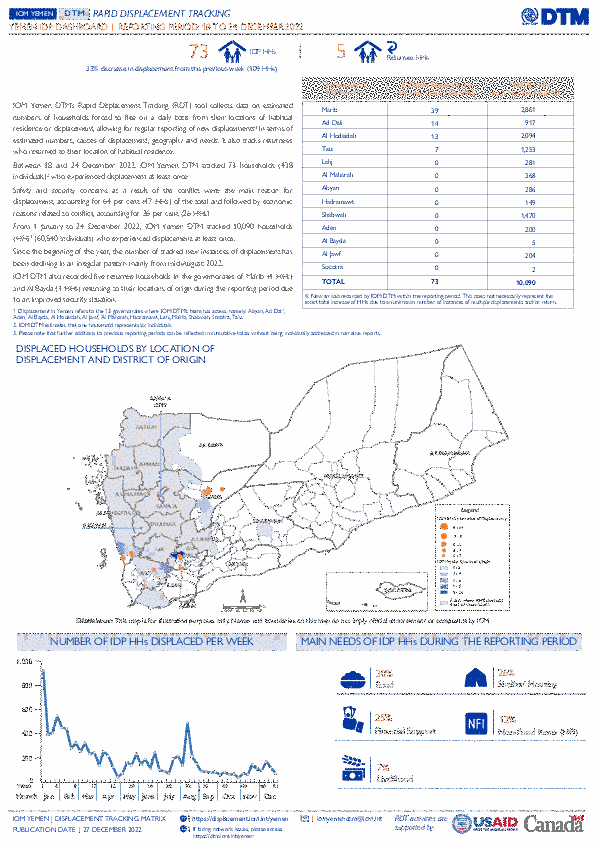
Contact
DTM Yemen, iomyemendtm@iom.int
Language
English
Location
Yemen
Period Covered
Dec 18 2022
Dec 24 2022
Activity
- Mobility Tracking
IOM Yemen DTM’s Rapid Displacement Tracking (RDT) tool collects data on estimated numbers of households forced to flee on a daily basis from their locations of origin or displacement, allowing for regular reporting of new displacements in terms of estimated numbers, geography, and needs. It also tracks returnees who returned to their location of origin.
From 1 January to 24 December 2022, IOM Yemen DTM tracked 10,090 households (HH) (60,540 Individuals) who experienced displacement at least once.
Between 18 and 24 December 2022, IOM Yemen DTM tracked 73 households (438 individuals) displaced at least once. The majority of people moved into/within the following governorates and districts:
- Marib (39 HHs) – Marib City (22 HHs), Marib (17 HHs) districts. Most displacements in the governorate originated from Ibb and Marib.
- Ad Dali (14 HHs) – Qatabah (10 HHs), Al Azariq (3 HHs), Ad Dali (1 HH) districts. Most displacements in the governorate originated from Ad Dali and Taiz.
- Al Hodeidah (13 HHs) – Hays (7 HHs), Al Khukhah (6 HHs) districts. Most displacements in the governorate were internal.
The majority of people moved from the following governorates and districts:
- Al Hodeidah (15 HHs) – At Tuhayta (5 HHs), Jabal Ras (3 HHs), Hays (3 HHs) districts.
- Taiz (13 HHs) – Mawiyah (5 HHs), Sabir Al Mawadim (2 HHs), Ash Shamayatayn (2 HHs) districts.
- Ad Dali (9 HHs) – Qatabah (9 HHs) district.
